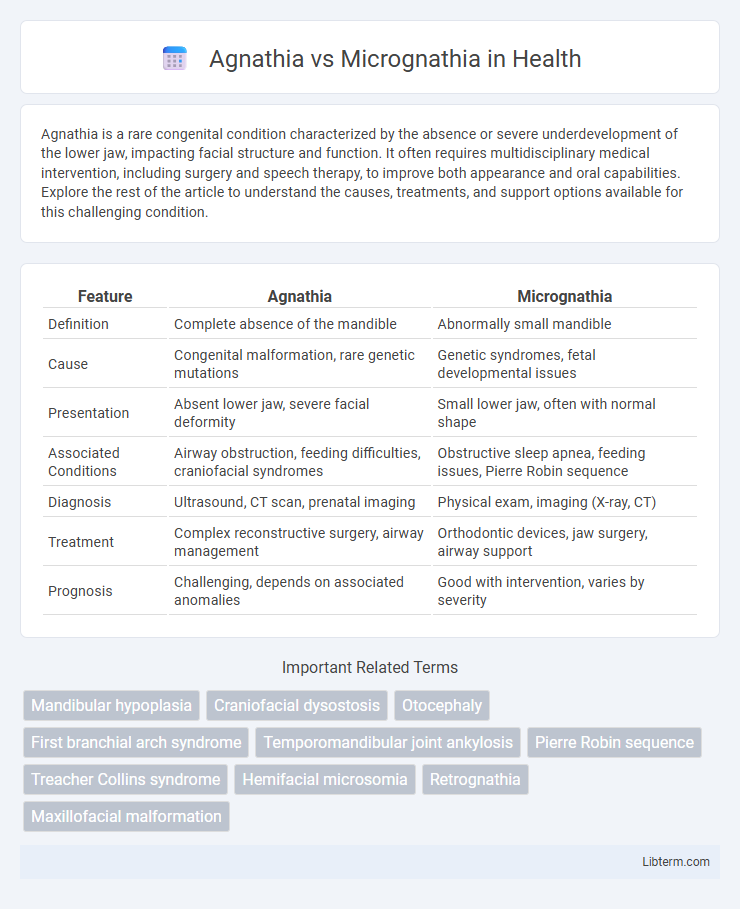Agnathia is a rare congenital condition characterized by the absence or severe underdevelopment of the lower jaw, impacting facial structure and function. It often requires multidisciplinary medical intervention, including surgery and speech therapy, to improve both appearance and oral capabilities. Explore the rest of the article to understand the causes, treatments, and support options available for this challenging condition.
Table of Comparison
| Feature | Agnathia | Micrognathia |
|---|---|---|
| Definition | Complete absence of the mandible | Abnormally small mandible |
| Cause | Congenital malformation, rare genetic mutations | Genetic syndromes, fetal developmental issues |
| Presentation | Absent lower jaw, severe facial deformity | Small lower jaw, often with normal shape |
| Associated Conditions | Airway obstruction, feeding difficulties, craniofacial syndromes | Obstructive sleep apnea, feeding issues, Pierre Robin sequence |
| Diagnosis | Ultrasound, CT scan, prenatal imaging | Physical exam, imaging (X-ray, CT) |
| Treatment | Complex reconstructive surgery, airway management | Orthodontic devices, jaw surgery, airway support |
| Prognosis | Challenging, depends on associated anomalies | Good with intervention, varies by severity |
Introduction to Agnathia and Micrognathia
Agnathia is a rare congenital condition characterized by the complete absence of the mandible, leading to severe facial deformities and challenges in airway management. Micrognathia involves an abnormally small mandible, frequently associated with syndromes such as Pierre Robin sequence, causing feeding difficulties and respiratory issues. Both conditions significantly impact craniofacial development, requiring specialized surgical and medical interventions for airway stabilization and functional improvement.
Definition and Key Differences
Agnathia is a rare congenital condition characterized by the complete absence of the mandible, whereas micrognathia involves an abnormally small but present lower jaw. Agnathia often results in severe functional impairments, including difficulties with breathing and feeding, while micrognathia primarily affects jaw shape and alignment, sometimes leading to conditions like obstructive sleep apnea. The key difference lies in the extent of mandibular development, with agnathia representing total mandibular agenesis and micrognathia indicating mandibular hypoplasia.
Causes and Risk Factors
Agnathia is a rare congenital condition characterized by the absence of the mandible, primarily caused by genetic mutations affecting craniofacial development during the embryonic stage, often linked to syndromes such as Treacher Collins or Goldenhar. Micrognathia involves an abnormally small mandible, commonly resulting from genetic disorders like Pierre Robin sequence or environmental factors including fetal alcohol syndrome and intrauterine growth restriction. Both conditions may arise from disruptions in neural crest cell migration and differentiation, with risk factors encompassing maternal illness, teratogen exposure, and familial genetic history.
Embryological Development
Agnathia and micrognathia are congenital craniofacial anomalies arising from disruptions in the embryological development of the first pharyngeal arch, which contributes to mandible formation. Agnathia results from severe failure in the migration or differentiation of neural crest cells, leading to an absent or nearly absent mandible, while micrognathia involves hypoplasia and underdevelopment of the mandible due to milder impairments in cellular proliferation or signaling pathways during early gestation. Both conditions highlight critical roles of genes like HOX and pathways such as BMP and FGF in mandibular morphogenesis within the embryonic stages, typically between weeks 4 and 8 of human development.
Clinical Presentation and Symptoms
Agnathia is characterized by the complete absence or severe underdevelopment of the mandible, often resulting in a visibly flat lower face and airway obstruction at birth, causing respiratory distress. Micrognathia presents as a significantly smaller-than-normal lower jaw, leading to feeding difficulties, airway obstruction, and potential cleft palate due to mandibular hypoplasia. Both conditions are congenital craniofacial deformities but differ in severity and the extent of mandibular development, requiring distinct clinical management strategies.
Diagnostic Methods
Diagnostic methods for Agnathia primarily involve prenatal ultrasound and 3D imaging techniques to identify the absence or severe underdevelopment of the mandibular bone. In contrast, Micrognathia diagnosis relies on detailed fetal MRI and cephalometric analysis to assess the degree of mandibular hypoplasia and airway obstruction risks. Genetic testing and postnatal physical examinations further aid in differentiating between these mandibular deformities for accurate clinical management.
Associated Syndromes and Conditions
Agnathia, characterized by the absence of the mandible, is commonly associated with syndromes such as Goldenhar syndrome and Treacher Collins syndrome, often resulting in craniofacial anomalies and ear defects. Micrognathia, defined by a significantly smaller jaw, frequently occurs in conditions like Pierre Robin sequence, Beckwith-Wiedemann syndrome, and Edwards syndrome (Trisomy 18), often leading to airway obstruction and feeding difficulties. Both anomalies are linked to genetic and developmental abnormalities, impacting airway management and requiring multidisciplinary intervention.
Treatment and Management Options
Treatment for Agnathia often involves complex surgical reconstruction, including mandibular distraction osteogenesis or autologous bone grafting to restore jaw function and facial symmetry. Management of Micrognathia typically includes orthodontic interventions, mandibular advancement devices, and in severe cases, surgical options such as mandibular osteotomy or distraction osteogenesis to improve airway patency and occlusion. Early multidisciplinary intervention with craniofacial specialists, orthodontists, and speech therapists is crucial for optimal functional and aesthetic outcomes in both conditions.
Prognosis and Outcomes
Agnathia, characterized by the complete absence of the mandible, often leads to severe airway obstruction and feeding difficulties, resulting in a poorer prognosis and higher mortality risk without early surgical intervention. Micrognathia, involving a smaller than normal mandible, may cause obstructive sleep apnea and feeding problems but generally has a better prognosis with appropriate medical management and potential corrective surgery. Outcomes for both conditions improve significantly with multidisciplinary care, though agnathia typically requires more complex reconstructive procedures and long-term follow-up.
Recent Advances and Research Trends
Recent advances in imaging technologies, such as high-resolution 3D ultrasound and cone-beam computed tomography, have enhanced early diagnosis and detailed assessment of Agnathia and Micrognathia, enabling more precise surgical planning. Genetic research has identified key mutations affecting mandibular development, with studies on gene editing showing potential for future therapeutic interventions. Current research trends emphasize multidisciplinary approaches combining genetics, bioengineering, and regenerative medicine to improve functional and aesthetic outcomes for patients with these craniofacial anomalies.
Agnathia Infographic

 libterm.com
libterm.com